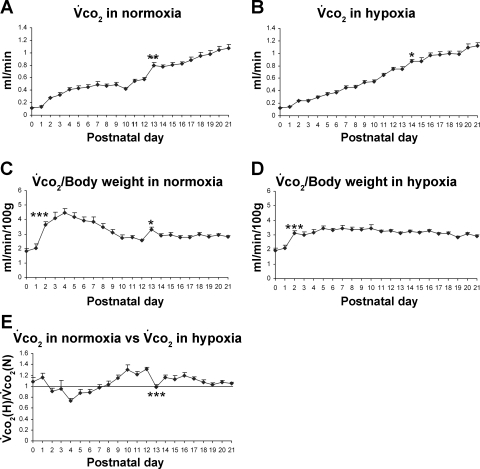Fig. 3.
Postnatal developmental trend of V̇co2 in normoxia and hypoxia. A: developmental trend of V̇co2 in normoxia. V̇co2 levels increased gradually with age, but significant successive age group increase is evident at P13 only. B: developmental trend of V̇co2 in hypoxia. Generally, V̇co2 levels progressively increased with age, but a significant rise occurred at P14, compared with P13. C: V̇co2 values normalized to body weight (100 g) in normoxia. V̇co2 was the lowest at P0–P1, increased significantly at P2, followed by a relative plateau for the remaining first postnatal week. The values were reduced and maintained at a relative plateau for the 2nd and 3rd postnatal weeks, except for a small but statistically significant peak at P13. D: V̇co2 normalized to body weight (100 g) in hypoxia. V̇co2 was the lowest at birth, increased significantly at P2, followed by fluctuations and a plateau until P21. E. V̇co2 in hypoxia [V̇co2(H)] vs. that in normoxia [V̇co2(N)]. One-sample t-test showed that the ratio was significantly different from 1 (P < 0.05) at P1, P4, P9–P12, and P14–P17. P13 is the only time point that shows a statistically significant difference between any adjacent 2 age groups (P < 0.001). For statistical comparisons between successive age groups, please see methods. *P < 0.05. **P < 0.01. ***P < 0.001.

